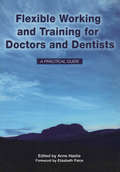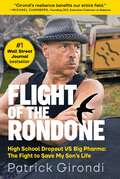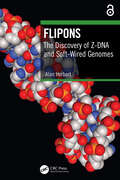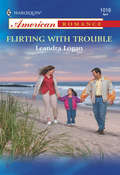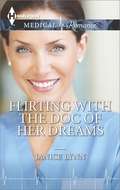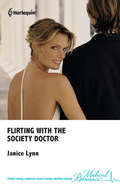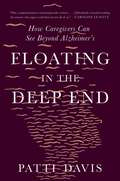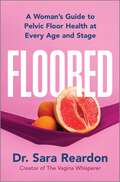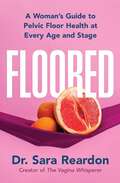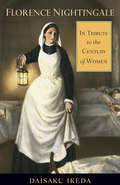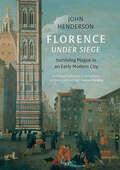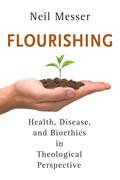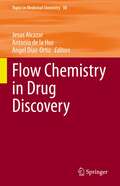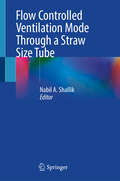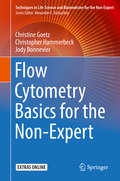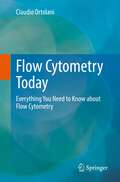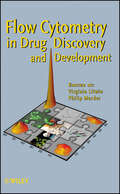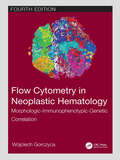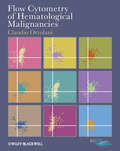- Table View
- List View
Flexible Working and Training for Doctors and Dentists: Pt. 1, 2007
by Anne Hastie Elisabeth Paice Elizabeth BoathThis work includes a foreword by Elisabeth Paice. "Flexible Training and Working for Doctors and Dentists" is a real-world, practical guide to the opportunities available for flexible training and working. It explains the current rules and regulations and promotes the 'Improving Working Lives' initiative for NHS workers - a Department of Health priority. It presents a wealth of information, including details on sabbaticals, management roles, maternity and sickness leave, academic life and the GP returner scheme. This straightforward guide will be invaluable to doctors and dentists working in primary and secondary care, medical and dental students and staff, and doctors and dentists in training. Healthcare policy makers and shapers will find it an excellent resource, along with healthcare managers and careers counsellors. "The first book on flexible training and working in medicine and dentistry. The subject matter is highly topical. The proportion of women in medicine and dentistry rises each year, and with it the demand for less than full-time working. This book will prove a useful resource for any doctors or dentists who are contemplating working less than full-time themselves, or who guide or manage others making these choices. Clinical tutors, course organisers and deanery staff will find it invaluable, and unique." - Elisabeth Paice, in her Foreword.
Flight of the Rondone: High School Dropout VS Big Pharma: The Fight to Save My Son's Life
by Patrick GirondiFlight of the Rondone is a true rags to riches tale the New York Times stated is &“meant for television.&” The protagonist, a high school dropout, is nicknamed in Italian U Carneveil (Walking Circus) for his entertaining and eccentric nature. Patrick Girondi starts his career shining shoes, stealing car parts, and escaping life-threatening situations while outwitting the Chicago police. He claws up to being a famous success story on the Oprah Show. His fortunes quickly change when his eldest son, Santino, is diagnosed with a fatal blood disease. Girondi hunts for a cure in a drama that has boundless implications in the world of gene therapy. As Girondi writes, &“I&’d been strangled, shot at, skated more than twenty arrests, made it through 3 FBI witch-hunts and went from the docks to trading and big money. I would see my son cured. How hard could it be?&” After decades of struggle, he delivered the world&’s first commercial batch of vector with the potential to cure Sickle Cell Disease and Thalassemia. But again, the success of the cure—and the fate of his son—is imperiled, in a world of lab jackets, mysterious deaths, and cut-throat Wall Street banksters. This is a story of love, beating the odds, or as Girondi calls it, pure luck. It is a gritty and realistic tale told with little regard for empire or etiquette.
Fling with Her Long-Lost Surgeon
by Sue MacKayIn the latest Harlequin Medical Romance from Sue MacKay, a fling with the surgeon from her past is just what the doctor ordered!Is the surgeon from her past……the answer to her future? Gynecologist Georgie has sworn off love for good—she&’s already lost more than she can bear. So when brooding surgeon Blake returns to town, the attraction zinging between them is something she should ignore. Yet Blake understands her more than anyone… Since he&’s only back temporarily, a fling could be just what the doctor ordered! Georgie tells herself it can never be forever—until she realizes how happy she is in his arms!From Harlequin Medical: Life and love in the world of modern medicine.
Fling with the Children's Heart Doctor
by Becky WicksWill she find a new home……In the surgeon&’s arms?For Dr. Freya Grey, spending six months working with Amsterdam&’s leading children&’s cardiac surgeon, Lucas Van de Berg, proves a delicious distraction from painful memories. But knowing that she can&’t stay in the city that haunts her, Freya is torn between her head and her heart. Lucas has shown her Amsterdam in a new light…but is that enough to make her want to stay? &“…absolutely entertaining, fast-paced and a story I couldn&’t put down…. Overall, Ms. Wicks has delivered a wonderful read in this book where the chemistry between this couple was strong; the romance was delightful and special….&”-Harlequin Junkie on From Doctor to Daddy &“An emotional roller coaster romance with both characters learning to trust, superb read.&”-Goodreads on Tempted by the Hot-Shot Doc
Flipons: The Discovery of Z-DNA and Soft-Wired Genomes
by Alan HerbertAlan Herbert has played a leading part in discovering the biological roles for a high-energy form of DNA twisted to the left rather than to the right. Both Z-DNA and the Z-RNA sensing proteins are critical for protecting hosts against both viruses and cancers. The proteins also play critical roles in the programmed cell death of aging cells. Other types of flipons exist and alter the readout of transcripts from the genome, encoding genetic information by their shape rather than by their sequence. Many of these flipons are within repeat elements that were previously considered to be just genomic junk. Instead these genetic elements increase the adaptability of cells by flipping DNA conformation. By acting as digital switches, the different flipon types can alter cellular responses without any change to their sequence or any damage to DNA. These highly dynamic structures enable the rapid evolution of multicellular organisms. The junk DNA in repeats also encode peptide patches that enable the assembly of cellular machines. The intransitive logic involved enhances the chance of an individual surviving a constantly changing environment.Key Features Causes us to rethink how information is encoded in the genome Changes our understanding of how our genome evolved and how we protect ourselves against viruses and cancers while sparing normal cells Shows that high energy forms of DNA, such as left-handed DNA do exist inside the cell Accessible to those in academia and the general public, and speaks to the next generation, encouraging them to find their own path in scientific discovery The Open Access version of this book, available at http://www.taylorfrancis.com, has been made available under a Creative Commons Attribution-Non-Commercial-No Derivative License (CC-BY-NC-ND) 4.0 license.
Flirting With Trouble
by Leandra LoganCan A High-Society Girl Give Up Life In The Fast Lane For Love In Fairlane? Shop-till-you-drop socialite Amanda Pierpoint is the New York gossip columnist everyone's gossiping about. Trying to please her father, she's almost ready to settle down — until Pierpoint Sr., the media mogul, goes too far. He's picked her future husband with less thought than he gives to his after-dinner cigar! Obviously it's time to get out of town. A pair of dark glasses and a dye job later, she's on the run — to a small dot on the map named Fairlane, where she causes a traffic mishap while ogling "Handsome" Hanson's taut muscles glistening in the noonday sun. Dr. Brett, as the locals call him, has secrets, too — his precocious daughter, ex-wife and red Corvette are all part of a hush-hush past. But their boardinghouse roomies are looking for intrigue. "Handsome" and Amanda falling for each other? That's perfect! Of course, when her father arrives with fiance in tow, her cover's blown and the truth comes out. Now what will the publicity-shy doctor do?
Flirting with the Doc of Her Dreams
by Janice LynnIt started with a text...Dr. Eli Randolph is nurse Beth Taylor's ultimate fantasy man. Gorgeous, kind, talented-he's ideal! Apart from the fact he doesn't know she exists...and Beth's had quite enough rejection for one lifetime.Then, thanks to an accidental risqué text message, suddenly Eli knows exactly who Beth is-and what she wishes she could do with him! Soon she's flirting like crazy with the doc of her dreams, and she's about to discover that sometimes reality is better than her imagination....
Flirting with the Florida Heart Doctor
by Janice LynnIn Janice Lynn&’s latest Harlequin Medical Romance, a doctor&’s challenge to start saying yes is put to the test when her charming cardiologist colleague asks her out on a date… SUN, SEA AND A SOULMATE? Having escaped a toxic relationship, Dr. Hailey is ready to embrace a sun-filled fresh start in Florida. With a new look and new attitude, Hailey&’s making a habit of saying yes…even to dinner with oh-so charming colleague Cayden! Despite mending hearts for a living, cardiologist Cayden has been unlucky with his own. Dating disasters have left him wary, but beautiful and vivacious Hailey draws him in. Yet regardless of their deepening connection, she&’s not looking for something serious. Is Cayden flirting with danger, or could they find the happy-ever-after they both stopped hoping for—together?From Harlequin Medical: Life and love in the world of modern medicine.
Flirting with the Socialite Doc
by Melanie MilburneThe new doc in town...Accepting a GP sting in a remote Australian town seems like the perfect opportunity for Lady Isabella Courtney to mend her broken heart. But keeping a low profile is easier said than done when she mistakes the-incredibly hot-local cop for a stripper!Zach Fletcher is back in Jerringa Ridge to take care of his injured father. And new doc Izzy is a delicious distraction he doesn't need. But something about her gets under her skin, and soon Zach finds himself flirting with trouble...!
Flirting with the Society Doctor
by Janice LynnFlirting with the Society Doctor Vale Wakefield is a spectacular doctor, but Faith Fogarty knows his for ever factor is nil and he ll always go for designer-clad socialites rather than colleagues in unflattering scrubs! Shes spent months fighting her attraction, but now, facing a weekend as Vales date to a society wedding! its time Faith took a few risks with the delicious doctor When One Night Isnt Enough Nurse Ali Forshay has swapped dating disasters for nights out with the girls! But after spending more time than is strictly necessary discussing the man she loves to hate the notoriously delicious Dr Jared Padget Alis horrifying realisation is that shes one hundred per cent crazy in lust with him! The conclusion: spend a feverish night together! It would be a strictly one-time-only experience Wouldnt it?
Floating in the Deep End: How Caregivers Can See Beyond Alzheimer?s
by Patti DavisWith the searching, exquisite prose of a loving daughter, Patti Davis provides a life raft for the caregivers of Alzheimer’s patients. “For the decade of my father’s illness, I felt as if I was floating in the deep end, tossed by waves, carried by currents, but not drowning.” In a singular account of battling Alzheimer’s, Patti Davis eloquently weaves personal anecdotes with practical advice tailored specifically for the overlooked caregiver. After losing her father, Ronald Reagan, Davis founded a support group for family members and friends of Alzheimer’s patients; drawing on those years, Davis reveals the surprising struggles and gifts of this cruel disease. From the challenges of navigating disorientation to the moments when guilt and resentments creep in, readers are guided gently through slow-burning grief. Along the way, Davis shares how her own fractured family came together, and how her father revealed his true self—always kind, even when he couldn’t recognize his own daughter. The result is an achingly beautiful work on the fragile human condition from a profoundly wise and empathetic writer.
Floored: A Woman's Guide to Pelvic Floor Health at Every Age and Stage
by Sara Reardon&“Floored is a transformative guide. A must-read for reclaiming comfort, dignity, and vitality.&”– Dr. Mary Claire Haver, Board Certified OBGYN and author of The New MenopauseThe definitive guide to pelvic floor health, written by pelvic floor physical therapist and creator of the Vagina Whisperer, Dr. Sara Reardon.Too many women put up with pelvic floor discomfort, thinking their symptoms are &“just part of motherhood and aging.&” And for far too long, the American health care system has normalized pelvic problems, leaving women feeling hopeless, ashamed and suffering in silence. Board-certified pelvic floor physical therapist Dr. Sara Reardon helps women prevent and overcome common pelvic floor issues so they can trust and enjoy their bodies again. Floored is a rallying cry for women&’s health and the authoritative guide for the pelvic floor, a critical group of muscles involved in day-to-day functions from peeing and pooping and sex and childbirth to menstruation and menopause. Whether you&’re navigating postpartum recovery, seeking relief from urinary incontinence or aiming to enhance sexual pleasure, this comprehensive resource provides the insights and strategies every woman needs. Inside the pages of this book, you will find: Education on pelvic floor anatomy and its critical role in your overall health. Practical advice for pelvic floor self-assessment and signs of potential issues. Exercises to strengthen, rehabilitate and maintain pelvic floor health across different life stages. Tips for treating common pelvic floor symptoms, such as involuntary urine leakage and painful sex.With clear and engaging guidance, Dr. Reardon demystifies the complexities of pelvic floor care and provides everything you need to ensure your pelvic well-being. The time to take control of your pelvic health is now.Learn about a variety of topics related to pelvic floor health, including: Menopause Menstruation Pregnancy and childbirth Postpartum care Painful sex Incontinence and prolapse Vaginal hygiene
Floored: A Woman's Guide to Pelvic Floor Health at Every Age and Stage
by Sara Reardon'A transformative guide to understanding and caring for the often-overlooked pelvic floor. A must-read for reclaiming comfort, dignity, and vitality' DR MARY-CLAIRE HAVER'should be required reading for everyone with a pelvic floor - which is everyone' Professor Emily OsterThe definitive guide to pelvic floor health, written by pelvic floor physical therapist and creator of the Vagina Whisperer, Dr Sara Reardon.Too many women put up with pelvic floor discomfort, thinking their symptoms are 'just part of motherhood and aging'. And for far too long, our health care system has normalized pelvic problems, leaving women feeling hopeless, ashamed and suffering in silence. Board-certified pelvic floor physical therapist Dr Sara Reardon helps women prevent and overcome common pelvic floor issues so they can trust and enjoy their bodies again.Floored is a rallying cry for women's health and the authoritative guide for the pelvic floor, a critical group of muscles involved in day-to-day functions, from wee-ing and poo-ing and sex and childbirth to menstruation and menopause. Whether you're navigating post-partum recovery, seeking relief from urinary incontinence or aiming to enhance sexual pleasure, this comprehensive resource provides the insights and strategies every woman needs.Inside the pages of this book, you will find:Education on pelvic floor anatomy and its critical role in your overall health. Practical advice for pelvic floor self-assessment and signs of potential issues.Exercises to strengthen, rehabilitate and maintain pelvic floor health across different life stages.Tips for treating common pelvic floor symptoms, such as involuntary urine leakage and painful sex.With clear and engaging guidance, Dr Reardon demystifies the complexities of pelvic floor care and provides everything you need to ensure your pelvic well-being.Learn about a variety of topics related to pelvic floor health, including:MenopauseMenstruationPregnancy and childbirthPostpartum carePainful sexIncontinence and prolapseVaginal hygieneThe time to take control of your pelvic health is now.
Florence Nightingale at Home
by Paul Crawford Anna Greenwood Richard Bates Jonathan MemelWinner of the 2021/2022 People's Book Prize Best Achievement AwardHomes can be both comforting and troubling places. This timely book proposes a new understanding of Florence Nightingale’s experiences of domestic life and how ideas of home influenced her writings and pioneering work. From her childhood homes in Derbyshire and Hampshire, she visited the poor sick in their cottages. As a young woman, feeling imprisoned at home, she broke free to become a woman of action, bringing home comforts to the soldiers in the Crimean War and advising the British population on the home front how to create healthier, contagion-free homes. Later, she created Nightingale Homes for nursing trainees and acted as mother-in-chief to her extended family of nurses. These efforts, inspired by her Christian faith and training in human care from religious houses, led to major changes in professional nursing and public health, as Nightingale strove for homely, compassionate care in Britain and around the world. Shedid most of this work from her bed after contracting the debilitating illness, brucellosis, in the Crimea, turning her various private homes into offices and ‘households of faith’. In the year of the bicentenary of her birth, she remains as relevant as ever, achieving an astonishing cultural afterlife.
Florence Nightingale: In Tribute to the Century of Women
by Daisaku IkedaFlorence Nightingale exemplified the incredible strength and capacity of a person fully awakened to her life's mission. Drawing inspiration from her life, eminent Buddhist philosopher and teacher Daisaku Ikeda shares insights that provide valuable lessons for men and women in today's world.
Florence Under Siege: Surviving Plague in an Early Modern City
by John HendersonA vivid recreation of how the governors and governed of early seventeenth-century Florence confronted, suffered, and survived a major epidemic of plaguePlague remains the paradigm against which reactions to many epidemics are often judged. Here, John Henderson examines how a major city fought, suffered, and survived the impact of plague. Going beyond traditional oppositions between rich and poor, this book provides a nuanced and more compassionate interpretation of government policies in practice, by recreating the very human reactions and survival strategies of families and individuals.From the evocation of the overcrowded conditions in isolation hospitals to the splendor of religious processions, Henderson analyzes Florentine reactions within a wider European context to assess the effect of state policies on the city, street, and family. Writing in a vivid and approachable way, this book unearths the forgotten stories of doctors and administrators struggling to cope with the sick and dying, and of those who were left bereft and confused by the sudden loss of relatives.
Flourishing: Health, Disease, and Bioethics in Theological Perspective
by Neil MesserWe use such words as "health," "disease," and "illness" all the time without stopping to consider exactly what we understand by them. Yet their meanings are far from straightforward, and disagreements over them have important practical consequences in health care and bioethics.In this book Neil Messer develops a distinctive and innovative theological account of these concepts. He engages in earnest with debates in the philosophy of medicine and disability studies and draws on a wide array of theological resources including Barth, Bonhoeffer, Aquinas, and recent disability theologies.By enabling us to understand health in the wider perspective of the flourishing and ultimate destiny of human beings, Messer's Flourishing sheds new light on a range of practical bioethical issues and dilemmas.
Flow Chemistry in Drug Discovery (Topics in Medicinal Chemistry #38)
by Antonio de la Hoz Jesus Alcazar Angel Díaz-OrtizThis book reviews the challenges and opportunities posed by flow chemistry in drug discovery, and offers a handy reference tool for medicinal chemists interested in the synthesis of biologically active compounds. Prepared by expert contributors, the respective chapters cover not only fundamental methodologies and reactions, such as the application of catalysis, especially biocatalysis and organocatalysis; and non-conventional activation techniques, from photochemistry to electrochemistry; but also the development of new process windows, processes and reactions in drug synthesis. Particular attention is given to automatization and library synthesis, which are of great importance in the pharmaceutical industry. Readers will also find coverage on selected topics of general interest, such as how flow chemistry is contributing to drug discovery R&D in developing countries, and the green character of this enabling technology, for example in the production of raw materials for the pharmaceutical industry from waste. Given its scope, the book appeals to medicinal chemistry researchers working in academia and industry alike, as well as professionals involved in scale-up and drug development.
Flow Controlled Ventilation Mode Through a Straw Size Tube
by Nabil A. ShallikThis book focuses on Flow-controlled Ventilation (FCV), the most recent innovation in the field of airway management and ventilation. In this book, the authors explain how ventilation through a straw-size or ultra-thin endotracheal tube is possible with FCV along with the clinical application of FCV in managing complex cases, particularly those presenting for head and neck surgery for a narrow airway diameter, totally obstructed airway and various cases of “cannot intubate, cannot oxygenate” situation. Readers will learn: the physical and physiological principles governing how FCV works; how to prepare and setup the FCV ventilators to be used with ultra-thin tube (outer diameter 4.4 mm and inner diameter 2.4 mm); identifying commonly encountered issues and troubleshooting; how to manage various cases of difficult airway encountered in various settings (prehospital or intra-operatively); how to tackle a “Cannot intubate, Cannot oxygenate” scenario in a simple way. The book is intended to be a reference guide that could be easily carried during the daily clinical work with the aim of providing a better healthcare and promoting patients’ safety. It is intended for healthcare providers working in various clinical settings including but not limited to intensivists, anaesthetists, pulmonary physicians, medical residents, medical students, medical fellows, anaesthesia residents, nurses, anaesthesia technical staff, respiratory therapists, certified registered nurses in anaesthesia, and paramedics.
Flow Cytometry Basics for the Non-Expert (Techniques in Life Science and Biomedicine for the Non-Expert)
by Christine Goetz Christopher Hammerbeck Jody BonnevierThis first edition volume demystifies the complex topic of flow cytometry by providing detailed explanations and nearly 120 figures to help novice flow cytometry users learn and understand the bedrock principles necessary to perform basic flow cytometry experiments correctly.The book divides the topic of flow cytometry into easy to understand sections and covers topics such as the physics behind flow cytometry, flow cytometry lingo, designing flow cytometry experiments and choosing appropriate fluorochromes, compensation, sample preparation and controls and ways to assess cellular function using a variety of flow cytometry assays. Written as a series of chapters whose concepts sequentially build off one another, using the list of materials contained within each section along with the readily reproducible laboratory protocols and tips on troubleshooting that are included, readers should be able to reproduce the data figures presented throughout the book on their way to mastering sound basic flow cytometry techniques. Easy to understand and comprehensive, Flow Cytometry Basics for the Non-Expert will be a valuable resource to novice flow cytometry users as well as experts in other biomedical research fields who need to familiarize themselves with a basic understanding of how to perform flow cytometry and interpret flow cytometry data. This book is written for both scientists and non-scientists in academia, government, biotechnology, and medicine.
Flow Cytometry Today: Everything You Need to Know about Flow Cytometry
by Claudio OrtolaniThis book covers all the technical aspects of flow cytometry needed to set-up the instrument, solve problems encountered in daily work, or necessary for exam preparation. It provides the reader with an in-depth look at the device and its applications. Each component and its function is described in an easy-to-understand manner, giving the reader a sound basic knowledge of this instrument. The practical examples given, simplify and enhance the learning process. This book is a unique resource of knowledge for biomedical engineers and biotechnologists, flow cytometry operators, laboratory technicians and biomedical researchers, both biologists as well as medical doctors, and can also be a helpful tool for companies and manufacturers.
Flow Cytometry in Drug Discovery and Development
by Virginia Litwin Philip MarderThis book covers the unique application of flow cytometry in drug discovery and development. The first section includes two introductory chapters, one on flow cytometry and one on biomarkers, as well as a chapter on recent advances in flow cytometry. The second section focuses on the unique challenges and added benefits associated with the use of flow cytometry in the drug development process. The third section contains a single chapter presenting an in depth discussion of validation considerations and regulatory compliance issues associated with drug development.
Flow Cytometry in Neoplastic Hematology: Morphologic-Immunophenotypic Correlation, Third Edition
by Wojciech GorczycaThis third edition is the product of the author’s 25 years of experience with flow cytometry; although it covers the wide spectrum of hematopoietic tumors, the focus remains on most important clinical diagnoses, such as acute promyelocytic leukemia, identification of blasts, identification of clonal B-cell population, differentiating mature versus immature T-cell proliferations, deferential diagnosis between hematogones and B-ALL or distinction between chronic and acute monocytic proliferations. All hematopathologists and neoplastic hematologists will find this an important resource for keeping up to date with developments in clinical practice.
Flow Cytometry in Neoplastic Hematology: Morphologic-Immunophenotypic-Genetic Correlation
by Wojciech GorczycaThis fourth edition presents an updated and expanded text and illustrations to reflect continued morphologic, immunophenotypic, and especially molecular advances in the field of neoplastic hematology, mostly due to the rapidly expanding application of next-generation sequencing. Those advances not only allow a more reliable diagnosis of the majority of tumors and identification of early changes such as monoclonal B-cell lymphocytosis or clonal hematopoiesis of indeterminate potential (CHIP), but also in many cases identify mutations or phenotypic changes in tumors that can be targeted by mutation-specific or antigen-specific drugs. This edition incorporates the updated WHO classification of hematopoietic tumors and new immunophenotypic and molecular markers to provide a thorough pathologic overview of hematologic neoplasms while focusing on flow cytometric features. Special emphasis has been put on hematological neoplasms with crucial clinical significance such as acute promyelocytic leukemia, other acute leukemias, and difficult areas in flow cytometry. Flow cytometric features in AML, MDS, CMML, CLL and measurable residual disease were significantly expanded. There are many new comparative tables, illustrations, and diagrams of algorithmic approaches.
Flow Cytometry of Hematological Malignancies
by Claudio OrtolaniFlow Cytometry of Hematological Malignancies contains an array of graphical outputs produced by the technique in the study of the most (and the least) common diseases. The images included allow you to compare your own results with a third party reference pattern. There is a detailed description of the main leukocyte antigens, together with a description of their distribution amongst normal and abnormal blood cells. The book also provides a comprehensive description of the phenotype of every neoplastic blood disease recorded in the WHO classification system, including all the instructions needed to recognise and classify even the least common entity.Designed to be practical, the book is perfect for quick consultation and is divided into two main sections. Section I deals with the direct object of immunophenotyping, and Section II deals with the ultimate target of the analysis. More than 50 antigens are covered and every antigen is dealt with in three main parts: general features, cytometric features and practical hints.This authoritative and state-of-the-art reference will be invaluable for clinicians directly involved in the diagnosis and analysis of hematological diseases, including hematologists, hematopathologists, oncologists, pathologists and technicians working in diagnostic laboratories.
